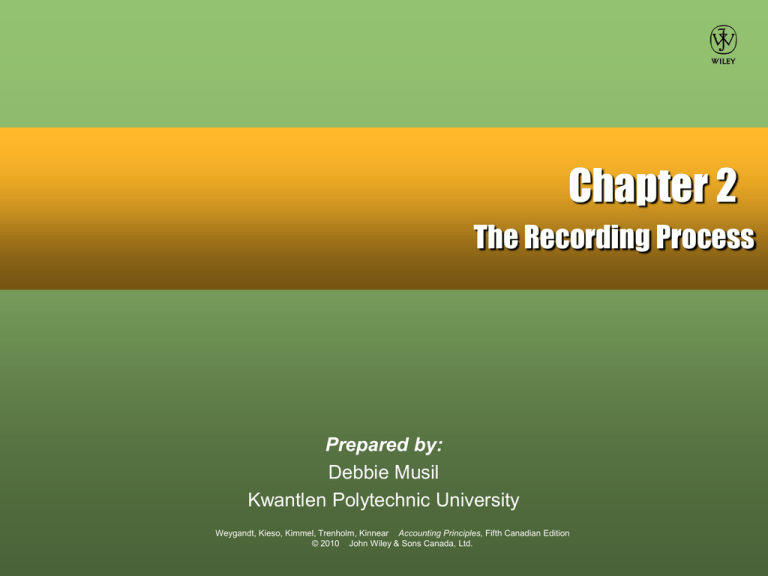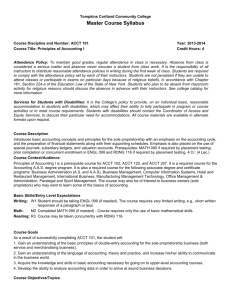
Chapter 2
The Recording Process
Prepared by:
Debbie Musil
Kwantlen Polytechnic University
Weygandt, Kieso, Kimmel, Trenholm, Kinnear Accounting Principles, Fifth Canadian Edition
© 2010 John Wiley & Sons Canada, Ltd.
The Recording Process
•
The account
• Debits and credits
• Expanding the basic accounting equation
•
The Recording Process
• The accounting cycle
• The journal and the ledger
•
The Trial Balance
• Limitations
• Locating errors
• Some simplistic assumptions
Weygandt, Kieso, Kimmel, Trenholm, Kinnear Accounting Principles, Fifth Canadian Edition
© 2010 John Wiley & Sons Canada, Ltd.
The Account
•
An individual accounting record of
increases and decreases in a specific
asset, liability, or owner’s equity item
• Examples: cash, salaries expense, accounts
payable
•
Three parts: title, debit side, credit side
• In its simplest form, these parts are positioned
like the letter T
• Therefore called a T account
Weygandt, Kieso, Kimmel, Trenholm, Kinnear Accounting Principles, Fifth Canadian Edition
© 2010 John Wiley & Sons Canada, Ltd.
Debits & Credits
•
Debit (Dr.) indicates left; Credit (Cr.) indicates
right
• Entering an amount on the left side is called
debiting the account
• Entering an amount on the right side is crediting
the account
•
Debit balance
• Debit amounts exceed the credits
•
Credit balance
• Credit amounts exceed the debits
Weygandt, Kieso, Kimmel, Trenholm, Kinnear Accounting Principles, Fifth Canadian Edition
© 2010 John Wiley & Sons Canada, Ltd.
Tabular Versus Account Form
Tabular Summary
Account Form
Cash
$15,000
- 7,000
1,200
1,500
- 600
- 900
- 200
- 250
600
- 1,300
$8,050
Cash
Debit
Credit
15,000
1,200
1,500
600
Balance
8,050
Weygandt, Kieso, Kimmel, Trenholm, Kinnear Accounting Principles, Fifth Canadian Edition
© 2010 John Wiley & Sons Canada, Ltd.
7,000
600
900
200
250
1,300
Double-entry System
•
Each transaction is recorded with equal
debits and credits
• Total debits always equals total credits
•
Accounting equation will always stay in
balance
• Assets = Liabilities + Owner’s Equity
•
Every account has a normal balance
• Either debit or credit
Weygandt, Kieso, Kimmel, Trenholm, Kinnear Accounting Principles, Fifth Canadian Edition
© 2010 John Wiley & Sons Canada, Ltd.
Assets, Liabilities & Owner’s Capital
Assets
Liabilities
Debit for
increase
Credit for
decrease
Debit for
decrease
Credit for
increase
Normal
balance
Normal
balance
Normal
balance
Normal
balance
Owner’s Capital
Debit for
decrease
Credit for
increase
Normal
balance
Normal
balance
Weygandt, Kieso, Kimmel, Trenholm, Kinnear Accounting Principles, Fifth Canadian Edition
© 2010 John Wiley & Sons Canada, Ltd.
Drawings, Revenues, Expenses
Drawings
Debit for
increase
Credit for
decrease
Normal
balance
Normal
balance
Revenues
Expenses
Debit for
decrease
Credit for
increase
Debit for
increase
Credit for
decrease
Normal
balance
Normal
balance
Normal
balance
Normal
balance
Weygandt, Kieso, Kimmel, Trenholm, Kinnear Accounting Principles, Fifth Canadian Edition
© 2010 John Wiley & Sons Canada, Ltd.
Accounting Equation Expanded
Assets
Dr
+
Cr
-
=
Liabilities
Dr
-
Cr
+
Owner’s
Capital
Dr
-
Owner’s Equity
+
Cr
+
-
Drawings
Dr
+
Cr
-
+
Revenues
Dr
-
Cr
+
Weygandt, Kieso, Kimmel, Trenholm, Kinnear Accounting Principles, Fifth Canadian Edition
© 2010 John Wiley & Sons Canada, Ltd.
-
Expenses
Dr
+
Cr
-
The Accounting Cycle
1
Analyze business transactions
9
Prepare post-closing trial balance
2
Journalize the transactions
8
Journalize & post closing entries
3
Post to general ledger accounts
7
Prepare financial statements
4
Prepare a trial balance
6
Prepare adjusted trial balance
5
Journalize & post adjusting entries
Weygandt, Kieso, Kimmel, Trenholm, Kinnear Accounting Principles, Fifth Canadian Edition
© 2010 John Wiley & Sons Canada, Ltd.
The Recording Process
The first three steps in the accounting cycle:
1. Analyze each transaction
•
Enter transaction in a journal
2.
•
3.
Determine effect on accounts
Book of original entry
Transfer journal information to ledger
accounts
Weygandt, Kieso, Kimmel, Trenholm, Kinnear Accounting Principles, Fifth Canadian Edition
© 2010 John Wiley & Sons Canada, Ltd.
The Journal
•
•
•
Where transactions are first recorded
Every company has a general journal
Contributes to recording process:
•
•
•
•
Discloses complete transaction in one place
Provides a chronological record
Helps prevent and locate errors
Provides explanation and identifies the source
document
Weygandt, Kieso, Kimmel, Trenholm, Kinnear Accounting Principles, Fifth Canadian Edition
© 2010 John Wiley & Sons Canada, Ltd.
Journalizing
•
•
•
Entering transaction data in the journal
Separate journal entry for each transaction
A complete entry consists of
• Transaction date
• Accounts & amounts to be debited and
credited
• Brief explanation of transaction
Weygandt, Kieso, Kimmel, Trenholm, Kinnear Accounting Principles, Fifth Canadian Edition
© 2010 John Wiley & Sons Canada, Ltd.
Journalizing Technique
• Transaction date is entered in date column
• Debit account title is entered at the left margin of the
“Account Titles and Explanation” column
• Credit account title is indented on the next line.
J1
GENERAL JOURNAL
Date
2011
Sept. 1
1
Account Titles and Explanation
Cash
M. Doucet, Capital
Invested cash in business.
Ref.
Debit
Credit
15,000
Equipment
Cash
Purchased equipment for cash.
Weygandt, Kieso, Kimmel, Trenholm, Kinnear Accounting Principles, Fifth Canadian Edition
© 2010 John Wiley & Sons Canada, Ltd.
15,000
7,000
7,000
Journalizing Technique 2
•
•
•
Debit amounts are recorded in the Debit column
Credit amounts are recorded in the Credit column
A brief explanation of the transaction is provided
J1
GENERAL JOURNAL
Date
2011
Sept. 1
1
Account Titles and Explanation
Cash
M. Doucet, Capital
Invested cash in business.
Ref.
Debit
Credit
15,000
Equipment
Cash
Purchased equipment for cash.
Weygandt, Kieso, Kimmel, Trenholm, Kinnear Accounting Principles, Fifth Canadian Edition
© 2010 John Wiley & Sons Canada, Ltd.
15,000
7,000
7,000
Journalizing Technique 3
•
•
•
Separate entries with a blank line
Ref. column is used later when transferred to ledger
List all debits in each entry before listing credits
J1
GENERAL JOURNAL
Date
2011
Sept. 1
1
Account Titles and Explanation
Cash
M. Doucet, Capital
Invested cash in business.
Ref.
Debit
Credit
15,000
Equipment
Cash
Purchased equipment for cash.
Weygandt, Kieso, Kimmel, Trenholm, Kinnear Accounting Principles, Fifth Canadian Edition
© 2010 John Wiley & Sons Canada, Ltd.
15,000
7,000
7,000
Journalizing Technique 4
•
•
Simple entry: involves two accounts
Compound entry: involves three or more
accounts
J1
GENERAL JOURNAL
Date
2011
Sept. 9
Account Titles and Explanation
Ref.
Debit
Cash
Accounts Receivable
Service Revenue
Performed services for cash
and credit
Weygandt, Kieso, Kimmel, Trenholm, Kinnear Accounting Principles, Fifth Canadian Edition
© 2010 John Wiley & Sons Canada, Ltd.
Credit
1,500
2,000
3,500
The Ledger
•
•
Ledger: entire group of accounts
maintained by a company
General ledger: contains all the assets,
liabilities, and owner’s equity accounts
• Arranged in financial statement order
• Assets, liabilities, owner’s capital, drawings,
revenues and expenses
•
Posting: procedure of transferring journal
entries to the ledger accounts
Weygandt, Kieso, Kimmel, Trenholm, Kinnear Accounting Principles, Fifth Canadian Edition
© 2010 John Wiley & Sons Canada, Ltd.
Standard Form of Account
D a te
2011
Sept. 1
1
3
9
17
17
20
25
30
30
Ge ne ra l Le d g e r
CASH
Exp la na tio n
R e f.
D e b it
Cre d it
15,000
7,000
1,200
1,500
600
900
200
250
600
1,300
Weygandt, Kieso, Kimmel, Trenholm, Kinnear Accounting Principles, Fifth Canadian Edition
© 2010 John Wiley & Sons Canada, Ltd.
Ba la nce
15,000
8,000
9,200
10,700
10,100
9,200
9,000
8,750
9,350
8,050
Posting
Ge ne ra l J o urna l
D a te Ac c o unt T itle a nd Exp la na tio n R e f
2011
01-Sep Cash
101
M. Doucet, Capital
301
Invested cash in business.
1
1.
2.
3.
4.
D e b it
J1
Cre d it
15,000
Ge ne ra l Le d g e r
Ca s h
D a te Ac c o unt T itle a nd Exp la na tio n R e f D e b it
2011
01-Sep
J1
15,000
Ge ne ra l Le d g e r
M. D o uc e t, Ca p ita l
D a te Ac c o unt T itle a nd Exp la na tio n R e f D e b it
2011
01-Sep
J1
15,000
3
2
101
Cre d it Ba la nc e
4
15,000
301
Cre d it Ba la nc e
15,000
15,000
Post to debit account: date, journal page number, amount
Enter debit account number in journal reference column
Post to credit account: journal page number, amount
Enter credit account number in journal reference column
Weygandt, Kieso, Kimmel, Trenholm, Kinnear Accounting Principles, Fifth Canadian Edition
© 2010 John Wiley & Sons Canada, Ltd.
Chart of Accounts
•
Lists accounts and their account numbers
• Indicates where accounts are found in the
ledger
• Usually starts with balance sheet accounts,
followed by income statement accounts
•
Varies by company
• Number of accounts
• Types of accounts
• Numbering system
Weygandt, Kieso, Kimmel, Trenholm, Kinnear Accounting Principles, Fifth Canadian Edition
© 2010 John Wiley & Sons Canada, Ltd.
The Trial Balance
•
•
•
•
List of accounts and their balances at a
specific time
Proves that debits equal credits after posting
Uncovers errors in journalizing and posting
To prepare a trial balance:
1. List accounts and their balances
2. Total the debit and credit columns
3. Ensure the two columns are equal
Weygandt, Kieso, Kimmel, Trenholm, Kinnear Accounting Principles, Fifth Canadian Edition
© 2010 John Wiley & Sons Canada, Ltd.
Example Trial Balance
PIONEER ADVERTISING AGENCY
Trial Balance
October 31, 2011
Cash
Accounts receivable
Advertising supplies
Prepaid insurance
Office equipment
Notes payable
Accounts payable
Unearned revenue
C. Byrd, capital
C. Byrd, drawings
Service revenue
Salaries expense
Rent expense
Debit
$ 14,250
1,000
2,500
600
5,000
Credit
$ 5,000
1,750
1,200
10,000
500
10,800
4,000
900
$ 28,700
Weygandt, Kieso, Kimmel, Trenholm, Kinnear Accounting Principles, Fifth Canadian Edition
© 2010 John Wiley & Sons Canada, Ltd.
$ 28,700
Limitations of a Trial Balance
•
Does not prove:
• That all transactions have been recorded, or
• That the ledger is correct
•
Numerous errors may exist even though
the trial balance columns agree
• Total debits and total credits may be equal,
but may still be posted to the wrong account
or in the wrong amount
Weygandt, Kieso, Kimmel, Trenholm, Kinnear Accounting Principles, Fifth Canadian Edition
© 2010 John Wiley & Sons Canada, Ltd.
Locating Errors
•
If trial balance does not balance, then:
• If error is an amount such as $1, $100 or
$1,000, re-add and re-calculate account
balances
• If divisible by two, look for entry in wrong
column
• If divisible by nine, look for transposition
errors
• Otherwise, scan to see if an account balance
has been omitted
Weygandt, Kieso, Kimmel, Trenholm, Kinnear Accounting Principles, Fifth Canadian Edition
© 2010 John Wiley & Sons Canada, Ltd.
COPYRIGHT
Copyright © 2010 John Wiley & Sons Canada, Ltd. All rights
reserved. Reproduction or translation of this work beyond that
permitted by Access Copyright (The Canadian Copyright
Licensing Agency) is unlawful. Requests for further information
should be addressed to the Permissions Department, John Wiley
& Sons Canada, Ltd. The purchaser may make back-up copies for
his or her own use only and not for distribution or resale. The
author and the publisher assume no responsibility for errors,
omissions, or damages caused by the use of these programs or
from the use of the information contained herein.
Weygandt, Kieso, Kimmel, Trenholm, Kinnear Accounting Principles, Fifth Canadian Edition
© 2010 John Wiley & Sons Canada, Ltd.


